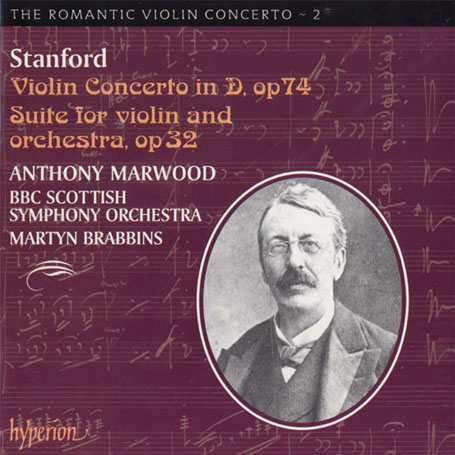Stanford Violin Concerto & Suite
This masterful work speaks with a distinctively beautiful voice and has a perfect advocate in Marwood and the BBC SSO
View record and artist detailsRecord and Artist Details
Composer or Director: Charles Villiers Stanford
Label: Hyperion
Magazine Review Date: 2/2001
Media Format: CD or Download
Media Runtime: 67
Mastering:
DDD
Catalogue Number: CDA67208

Tracks:
| Composition | Artist Credit |
|---|---|
| Concerto for Violin and Orchestra |
Charles Villiers Stanford, Composer
Anthony Marwood, Violin BBC Scottish Symphony Orchestra Charles Villiers Stanford, Composer Martyn Brabbins, Conductor |
| Suite for Violin and Orchestra |
Charles Villiers Stanford, Composer
Anthony Marwood, Violin BBC Scottish Symphony Orchestra Charles Villiers Stanford, Composer Martyn Brabbins, Conductor |
Author: Michael Oliver
This is a discovery of major importance. Hubert Parry (no mean critic) regarded Stanford’s Violin Concerto as one of his finest works, yet it has been played rarely, if at all, since his death in 1924: Jeremy Dibble’s exemplary notes refer to an ‘unpublished full score and parts recently discovered in the library of the Royal College of Music’. I think Parry was quite right in his assessment, but one preliminary word of warning: despite Stanford’s reputation as a disciple of Brahms, don’t listen to this concerto expecting it to sound Brahmsian. Often enough it does, but when it doesn’t it isn’t because Stanford has failed to match the quality of his ‘model’; far more often it’s because he is going his own way, speaking with his own and not a derivative voice. The very opening of the concerto is a case in point: the soloist’s melody is accompanied by a beautifully delicate texture of plucked strings and rippling woodwind. I don’t think there’s anything quite like it in Brahms; nor is Brahms always so generous with his thematic material as Stanford is in this movement. After that ‘first subject’ and an extensive and varied ‘second subject group’, a big and dramatic orchestral tutti leads not to the expected development but to a new and quite splendid theme. There’s plenty of room for virtuosity, but very often the display is modified by a pensive quality, a reticence, that is seemingly Stanford’s own, and most attractive.
The slow movement is also notable for its individual scoring (very spare at the outset; a magical return of the melancholy opening melody at the end over murmuring tremolando strings) and for its melodic distinction. The sadness of the first theme is again reticent, adding greatly to the eloquence of the heartfelt tutti that leads to the finest theme in the entire work, upon which Stanford lavishes rhapsodic figuration of great beauty. The finale is lighter and quite short – an economical rondo on a jovial Irish theme – but its exuberance is finely and subtly crafted.
I cannot think of a player better suited to bringing this concerto back to life than Anthony Marwood. He easily surmounts its technical demands, but his distinction as a chamber musician enables him to seek out all its quieter subtleties and pensive asides. The Suite is a lesser but highly entertaining work, an exercise in neo-baroque designed as a warmly affectionate tribute to Joseph Joachim. Its sheer ingenuity (the first movement, for example, is a combination of sonata form and two sets of interlocked variations) saves it from being a mere exercise, and its melodic freshness from being a mere makeweight to the masterly concerto. First-class orchestral playing, sympathetically conducted, and a recording that is both clean and spacious.'
The slow movement is also notable for its individual scoring (very spare at the outset; a magical return of the melancholy opening melody at the end over murmuring tremolando strings) and for its melodic distinction. The sadness of the first theme is again reticent, adding greatly to the eloquence of the heartfelt tutti that leads to the finest theme in the entire work, upon which Stanford lavishes rhapsodic figuration of great beauty. The finale is lighter and quite short – an economical rondo on a jovial Irish theme – but its exuberance is finely and subtly crafted.
I cannot think of a player better suited to bringing this concerto back to life than Anthony Marwood. He easily surmounts its technical demands, but his distinction as a chamber musician enables him to seek out all its quieter subtleties and pensive asides. The Suite is a lesser but highly entertaining work, an exercise in neo-baroque designed as a warmly affectionate tribute to Joseph Joachim. Its sheer ingenuity (the first movement, for example, is a combination of sonata form and two sets of interlocked variations) saves it from being a mere exercise, and its melodic freshness from being a mere makeweight to the masterly concerto. First-class orchestral playing, sympathetically conducted, and a recording that is both clean and spacious.'
Discover the world's largest classical music catalogue with Presto Music.

Gramophone Digital Club
- Digital Edition
- Digital Archive
- Reviews Database
- Full website access
From £8.75 / month
Subscribe
Gramophone Full Club
- Print Edition
- Digital Edition
- Digital Archive
- Reviews Database
- Full website access
From £11.00 / month
Subscribe
If you are a library, university or other organisation that would be interested in an institutional subscription to Gramophone please click here for further information.




